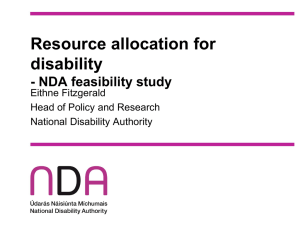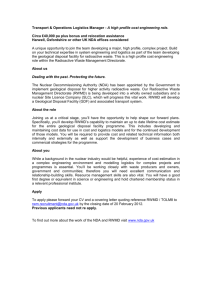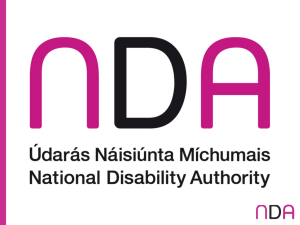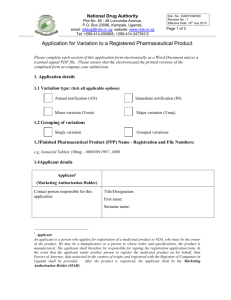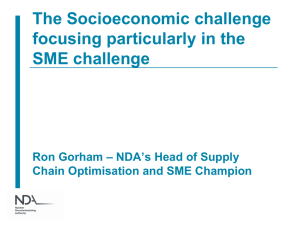Broadcasting Authority of Ireland Access Rules Review
advertisement
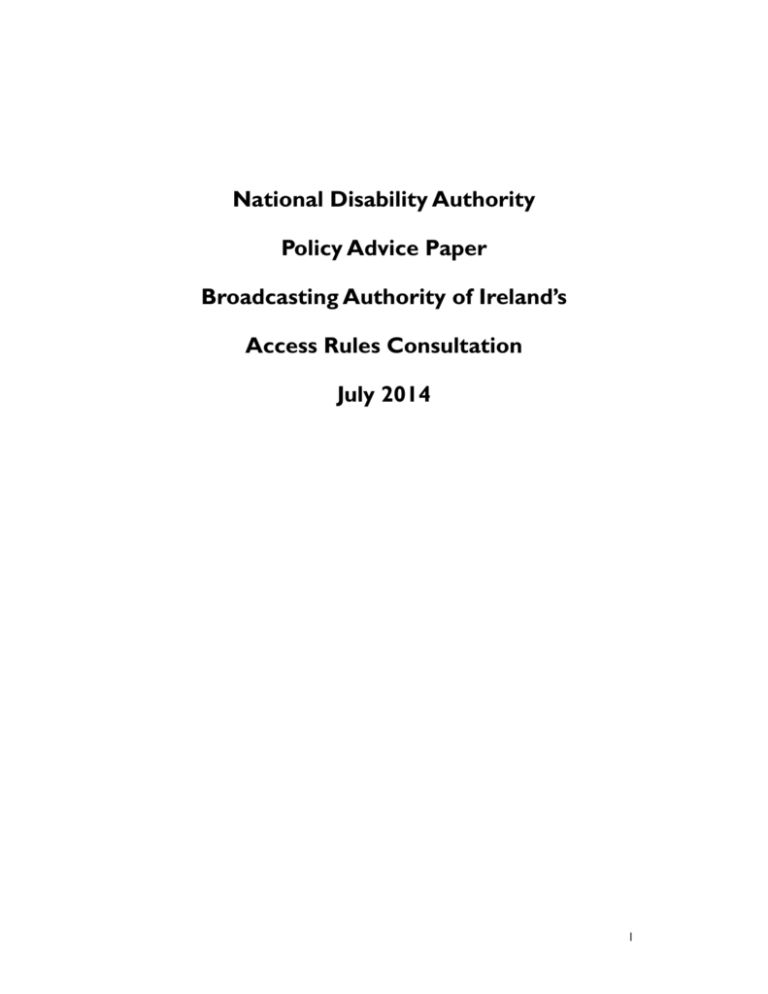
National Disability Authority Policy Advice Paper Broadcasting Authority of Ireland’s Access Rules Consultation July 2014 1 Question 1: What are your views on the proposed subtitling targets as detailed above? We note that users confirm they are happy with a range rather than fixed targets, and we welcome the progressive increase proposed in the proportion of content to be subtitled. We welcome the retention of the five-year target period and the biennial review of how those targets are being met as a realistic and manageable process. We welcome the extension of the subtitling targets to the other RTE services. In particular the NDA has emphasised the accessibility of children’s programmes. Given the establishment of RTEjr is there a need to review the text of Access Rule 6.2? Is this text still relevant to the TRTE strand that is broadcast on RTE Two? The end-to-end provision of access services is an increasingly complex process with many intermediaries involved including programme creators, film companies, broadcasters, re-broadcasters (e.g. SKY), and platform providers such as UPC, SKY etc. The NDA is aware of issues with the quality of subtitling, provided by broadcasters and what is received by viewers. The NDA recommends that the BAI consider conducting research into the ‘lived experience’ of Irish viewers in using accessible services in order to independently assess issues with the quality and quantity of accessible services provided by broadcasters. Similar research has been conducted in other jurisdictions and the NDA has also conducted similar research in other domains. The NDA is available to advise on conducting this research. Question 2: What are your views on the proposed targets for audio description? Broadcasters should already be planning for the provision of closed audio description via a “red button” command. This facility should lead to a gradual increase in concurrent audio description services which would help achieve the mainstreaming of accessible broadcasting. The NDA welcomes the extension of audio description to RTEjr and the higher percentage target assigned to that channel. The NDA believes that the overall targets for audio description are still insufficient and recommends that the BAI considers increasing these targets, in consultation with broadcasters. Where 2 possible the limited resources for audio description should be targeted at civic participation and public information broadcasts. Question 3: What are your views on the proposed targets for Irish Sign Language? While the number of users is small1 an absence of regular ISL provision in broadcasting means such users are often profoundly excluded from the social and cultural experiences that broadcasting provides. The NDA welcomes the commitment to ISL interpretation of broadcasts and its extension to the other RTE services mentioned in the document. However, we would like to see more ambitious targets set. Given the very low starting point, we also suggest that consultation take place with the Deaf community in relation to what would be prioritised for extending the range of ISL programming. In terms of active citizenship, news and current affairs broadcasting relating to elections or referenda are very important, and we advise a special effort be made to ensure that the Deaf community can have access to the flavour of the debate on the referendum scheduled for 2015. Question 4: What are your views on the proposed approach to be used by the BAI to measure compliance with the Access Rules? Broadcasters have had a number of years to implement the Access Rules and progress is still slow. Compliance measures need to be tighter. The BAI should consider adopting Ofcom’s annual statement of those channels required to provide access services.2 Ofcom have also seen to it that broadcasters that did not meet their targets in a certain year will carryover the percentage shortfall into the next year3. 1 Census 2011 showed that some 2,600 people use Irish Sign Language as the language of the home. 2 http://stakeholders.ofcom.org.uk/broadcasting/guidance/otherguidance/tv_access_serv/channels-access-services2014/?utm_source=updates&utm_medium=email&utm_campaign=access-services-required-2014 3 http://stakeholders.ofcom.org.uk/binaries/consultations/accessservs/summary/access.pdf, page 3 3 The NDA believes the BAI User Consultative Panels should meet at least three times a year rather the minimum of one meeting currently prescribed. More contact should foster greater understanding and awareness of the issues. In our 2012 submission we highlighted that the quality of subtitling should also be a factor in determining compliance; we welcome the proposal to adopt this measure by the BAI. Question 5: What are your views on this approach to the setting of targets for new television services? The NDA welcomes this proposal. We advocated this approach in our 2012 submission. We stated that: New Digital TV channels should be required, as part of the licence application process, to set out how they propose from the outset to build-in accessibility to their programming, and how they propose to expand the proportion of accessible programming over time. Question 6: What are your views on this approach to the changing of the length of the broadcast day for certain television services? The NDA supports this proposal. Question 7: Are there any other issues that you would like to highlight in respect of the proposed Access Rules? Public service broadcasting is now transmitted to and received on a variety of devices. This includes platforms such as the web and using media players such as the RTE Player. It should be taken into account that people with disabilities have the same access needs in relation to content broadcast via these platforms as they do for content broadcast via the DTT, satellite and cable platforms. The RTE Player is also available for use on mobile devices. In recognition of the existing and projected convergence of broadcasting technologies, NDA is aware of legislation in other regions such as the 21st 4 Century Communications & Video Accessibility Act4 in the USA which requires that broadcasters that provide content with subtitles on TV must also ensure that the same content be subtitled when broadcast via the web. Article 7 of the Audiovisual Media Services Directive (2010/13/EU)5 states that: Member States shall encourage media service providers under their jurisdiction to ensure that their services are gradually made accessible to people with a visual or hearing disability The NDA recommends that the BAI seek a change to existing legislation in order to extend the remit of the Access Rules to cover all devices that can receive RTE programming. This would make the Access Rules consistent with the extension of the new Public Service Broadcasting Charge to all such devices where they are liable for the payment of the new charge. The United Nations Convention on the Rights of Persons with Disabilities6 will be ratified by Ireland once all the necessary legislative and administrative requirements under the Convention have been met. Further to the Convention, States have an immediate obligation to ensure a minimum essential level of enjoyment of each economic, social and cultural right. States also have an obligation to take steps towards the progressive realisation of these rights. In this regard Article 30 states that people with disabilities: Enjoy access to television programmes, films, theatre and other cultural activities, in accessible formats When Ireland has to report on these matters it will be asked to what extent progress has been made. By keeping the Access Rules under periodic review and – possibly – extending their reach, the BAI will make a strong contribution towards this progressive realisation. The NDA is aware of accessibility issues reported to the BAI on its current access rules consultation website. The NDA welcomed the opportunity to assist the BAI by providing advice on how to address some of these issues and acknowledges the BAI’s efforts to provide content is a variety of formats. 4 http://www.govtrack.us/congress/bills/111/hr3101/text 5 http://ec.europa.eu/avpolicy/reg/avms/index_en.htm 6 http://www.un.org/disabilities/default.asp?id=290 5 The NDA will continue to provide advice when requested and recommends that the BAI review the accessibility of its online presence in line with recommended international standards - WCAG 2.07. 7 http://www.w3.org/TR/WCAG20/ 6 Appendix- Facts and figures on disability Numbers of people with disabilities with individual difficulties/impairments, 20068 Many people have more than one category of difficulty so numbers are not mutually exclusive Physical disability Mobility difficulties - difficulty walking 15 minutes - uses a wheelchair Difficulty using hands/fingers Pain Breathing difficulty Sensory disability Difficulty seeing (while using glasses) - cannot see Hearing difficulties - cannot hear Speech difficulties - cannot speak Mental health Mental health difficulty - depression - anxiety disorder - schizophrenia Intellectual disability Diagnosed intellectual disability 184,000 160,000 35,000 79,000 153,000 72,000 50,000 2,300 58,000 1,800 35,000 6,400 110,000 31,000 14,000 5,000 50,000 8 Based on the 8.1% of the population who reported a disability in both Census 2006 and the follow-up National Disability Survey 7
